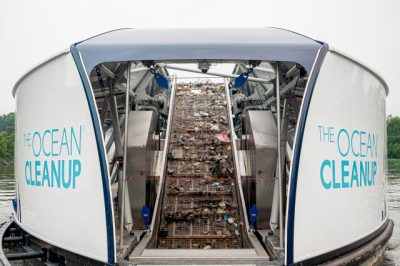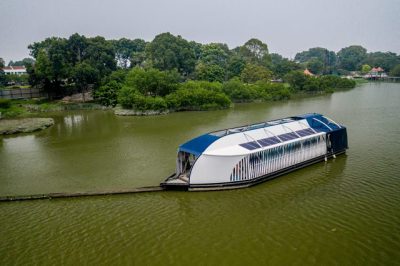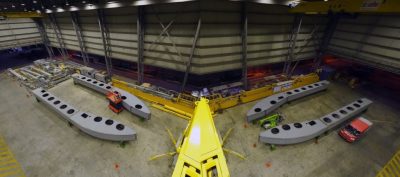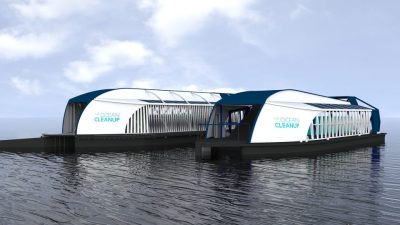The Great Pacific Garbage Patch is just one of a number of pollution disasters affecting the world’s oceans. All over the globe, huge amounts of plastic enter waterways every day, causing havoc in delicate ecosystems.
Heading up the charge to deal with the problem, The Ocean Cleanup have been working on a variety of projects to help clean up plastic pollution. Chief among these is their river cleanup efforts, aiming to stop plastic pollution from reaching the ocean in the first place. The non-profit group intends to rapidly scale up its efforts, partnering with Finnish industrial manufacturer Konecranes in order to put its latest river cleaning design into series production.
We last reported on the group’s efforts in 2020, with their Interceptor craft operating in rivers in Malaysia, Indonesia, and the Dominican Republic. They’ve since refined the design for better functionality and easier deployment. Let’s jump in and see what they’ve learned and how their hunt for plastic pollution is shaping up.
A Gargantuan Task

The Ocean Cleanup was founded in 2013, aiming to find a solution to clean up plastic pollution in the open ocean. However, in years, since the group’s focus has shifted to other areas as well, as modelling has shown that stemming plastic flows from the world’s rivers can be more effective than capturing it once it’s in the ocean itself.

Much focus has been placed on correctly identifying the greatest sources of plastic pollution, in order to best focus the cleanup where it can make the biggest difference. The latest research dives deep into the causal factors behind plastic outflows, and further reinforces previous studies that suggest up to 80% of ocean plastic flows out of just 1,000 rivers worldwide. Populated areas close to rivers or oceans, particularly those with poor waste management practices, are the most likely to produce large amounts of plastic pollution that finds its way to the ocean. Other factors, such as rainfall and terrain elevation can also play a role in where discarded plastic ends up.
Taking Things Up A Notch
The Ocean Cleanup has taken the lessons learned from its first four river-based Interceptor craft, which autonomously collect plastic waste from rivers before it can flow out to the ocean. This knowledge has led to the development of the upgraded third-generation Interceptor, which aims to work more efficiently than its predecessors. The new design mounts a bigger conveyor belt and larger dumpsters to process larger amounts of trash with less blockages. It’s also been redesigned with an eye to containerization, allowing Interceptors to be more readily shipped around the world and deployed more easily.

Two of the new Interceptors are being manufactured in Konecranes’ MHE-Demag facility in Malaysia for future deployment, with a further craft designated for Los Angeles later this year. It’s intended for the Finnish company to run production and servicing for the Interceptor craft going forward, drawing on their industrial machinery experience to build and maintain the fleet in the most efficient manner possible. Mainstream rock band Coldplay have also jumped on board, sponsoring the build of Interceptor-005, with the band citing their passionate support of the project.

In an interview with CNET, CEO Boyan Slat highlighted that the first two Interceptors built with Konecranes will be used to validate the operational model, while not providing a clear timetable for full series production. The company has committed to production of ten Interceptors at this stage. The upgrades will be key to the success of the project, with Slat stating “We’ve found that we can still further reduce the cost, the ease of rollout and the ease of assembly to really speed up the deployment as much as possible while also making it more efficient.” He goes on to say “We found [the previous Interceptor] often would clog when it comes to very large debris. So widening that will help also improve the reliability of the operation.”
Today the Rivers, Tomorrow the Ocean
The organisation hasn’t forgotten about the ocean either, with the group set to deploy System 002 in 2021 – the latest iteration of its ocean-scouring rig. It aims to solve some of the operational issues with earlier designs of the group’s original headline project, which struggled to effectively collect large amounts of garbage in early deployments. As an aside to the project, The Ocean Cleanup also produced a run of sunglasses produced with the plastic harvested in early missions. However, the effort was more of an aid to promote the group’s work rather than a major push towards commercialization. “We don’t plan to become a products organisation; our focus is to clean the oceans,” said Slat.
With a thousand rivers and the entire Great Pacific Garbage Patch on the organisation’s target list, obviously a huge amount of funding will be required to produce enough Interceptors to do the job, as well as a monumental effort to work with local governments on the red tape prior to deployment. The basic concept remains a good one, and the hardware better than ever, but The Ocean Cleanup still faces an uphill battle in the fight against water-borne plastic pollution.
















It is a welcome solution for macroplastic, but i suspect it’s only the tip of the plastiberg, and smaller or just non-floating debris won’t be caught by this setup…
What’s big becomes small and myriad.
But the problem with microplastics is overstated, because the smaller the particle is the easier it is to attack by microbes, and they do eat plastics just as they consume naturally occurring petroleum seeps etc. The confusion comes from the fact that “microplastics” means anything up to 5 mm in size, which is what gets ingested by fish and birds, not by bacteria.
Absolutely. Especially in a salt water environment. Salt water is corrosive and will break down and destroy any man-made material. That being said, I support this clean up effort. You make a mess, you clean it up.
Removing macro-plastic will great reduce the secondary micro-plastics (those that come from macro-plastics being broken down). It will miss primary micro-plastic (plastic micro-balls in shampoo and such), but those should be illegal anyway. In the end all the macro-plastics will eventually become micro-plastics, so catching those early should be a great help.
I dive regularly in Asia, and it seems to me that most of the plastic crud captures some air and ends up floating at the surface, or just below it. The main exceptions seem to be metallized polymers, like chips bags and the like, and bottle caps and utensils.
Things have also improved during the current virus situation, as it used to be I’d have to take out my net bag every other dive to haul garbage up, but it’s been a while since I did that. On the other hand, due to travel restrictions I’ve only been diving a single area that does a very good job with its garbage disposal to begin with.
Overall I’m glad folks are starting to focus on the problem closer to the source. Picking this stuff up in a river is so much more efficient than hunting for it in the vastness of an ocean. Next up: how about a public awareness campaign in the countries that cause the most pollution?
so in these places what keeps the river from staying the semi automated waste disposal system it always has been.. except now somebody is collecting the garbage for free down stream somewhere?
For the humans living there, relatively clean plastic waste is probably the least concern. They’ll have plenty of reason to fix up waste management to clean up the water for irrigation and drinking water purposes.
Yes, IF they are truly concerned about life on this planet. Take for instance the garbage heaps at the camps on Mt. Everest. It seems to me many countries have not accepted responsibility for their messes. For instance, traditions in countries like India at the Ganges, where people insist on bathing in polluted water on the basis of religious beliefs that are clearly not beneficial to humans. Then there is China with its 3 Rivers project which is obviously a disaster in the making. So many places around the world have been proven as ecological train wrecks such as super fund sites here that are not being dealt with beyond marking them as restricted access, now we have nuclear waste contaminated regions such as in Russia, Japan, not to mention just dealing with the non catastrophic boondoggles of disposing of depleted nuclear wastes. Yes I know this is about plastic but it just seems to me we are at a point of TOO little TOO late along with the over size task of basically just a few people trying to attack a world wide issue which I equate to putting out a towering inferno with a squirt bottle. I just don’t see it happening. So many people will discredit the idea of an all supreme creator, but so many cultures insist there is one and with that, everything we observe on this earth would have been created by that force and we had no inclination to honor that gift. Now the only thing can save us and this earth is for that force to step in and undo all that we have done. In the Christian scriptures @ Jeremiah 10;23 it tells us we are not walking to direct our own lives, it does not belong to us to determine our destiny. At Mathew 24;22 we are told that the days of this world, not the earth mind you, but the system we have constructed around ourselves, will be cut short lest NO flesh survives. We are positively killing everything living on this planet which was gifted to us as an inheritance. We sure showed how much we appreciated that gift. Humans have done more destruction in the last 100 years that all that was done combined in over 2000 years prior and we can see how that has depleted resources and life in those 100 years, we don’t have another 50 years to undo that and save our home.
Is it at all possible to just use less plastic? I mean, not from the consumer end, top down issue this is.
Probably, however plastic breaks down so much faster than glass, ceramic, aluminum (maybe?) and stainless steel alternatives.
… and the energy requirements for making plastic containers are perhaps the lowest of them all, too.
By that mentality the cheapest solution MUST be the right solution. Why haven’t we looked at more bio degradable packaging to address pollution issues? I say more because there so many bio D’s out there but more seems like a logical direction. Of course we could just wipe out all the tress and see how that works out for us. At least recyclable products makes a lot of sense too and plastic is recyclable if people would just do it.
I didn’t read the article, however I am curious how they deal with wildlife that is living amongst the garbage. I’m guessing in the larger scheme of things it isn’t as important. Especially since it is losing it’s habitat (however trashy).
I’ve wonder the same for while. If we dragged a big net over the Pacific Garbage Patch (or some how scooped it all up), how much wild life would we kill? What is the over impact of that vs the longer term risk of plastic breaking down and potentially harming the food chain?
But then comparing the damage of scooping up the Pacific Garbage Patch, to the damage caused by industrial bottom trawling over say 10 years (or all ocean fishing/harvesting), and the environmental cost (i.e. killing wild life) of cleaning up ocean and river soon-to-be-ocean garbage does seem worth it to advert a larger environmental catastrophe when decades of large scale plastic dumping adversely affects the food chain.[1]
I guess over time clean up systems to develop to minimize the environmental cost of the clean up.
[1] – I don’t have the figures for biomass of the Pacific Garbage Patch, or the biomass of industrial fishing. [2]
[2] – It’s probably more complicated than biomass.
Someone should tell them that they will need wheels for their LA river version…..Like Harry, the Europeans will never understand LA.